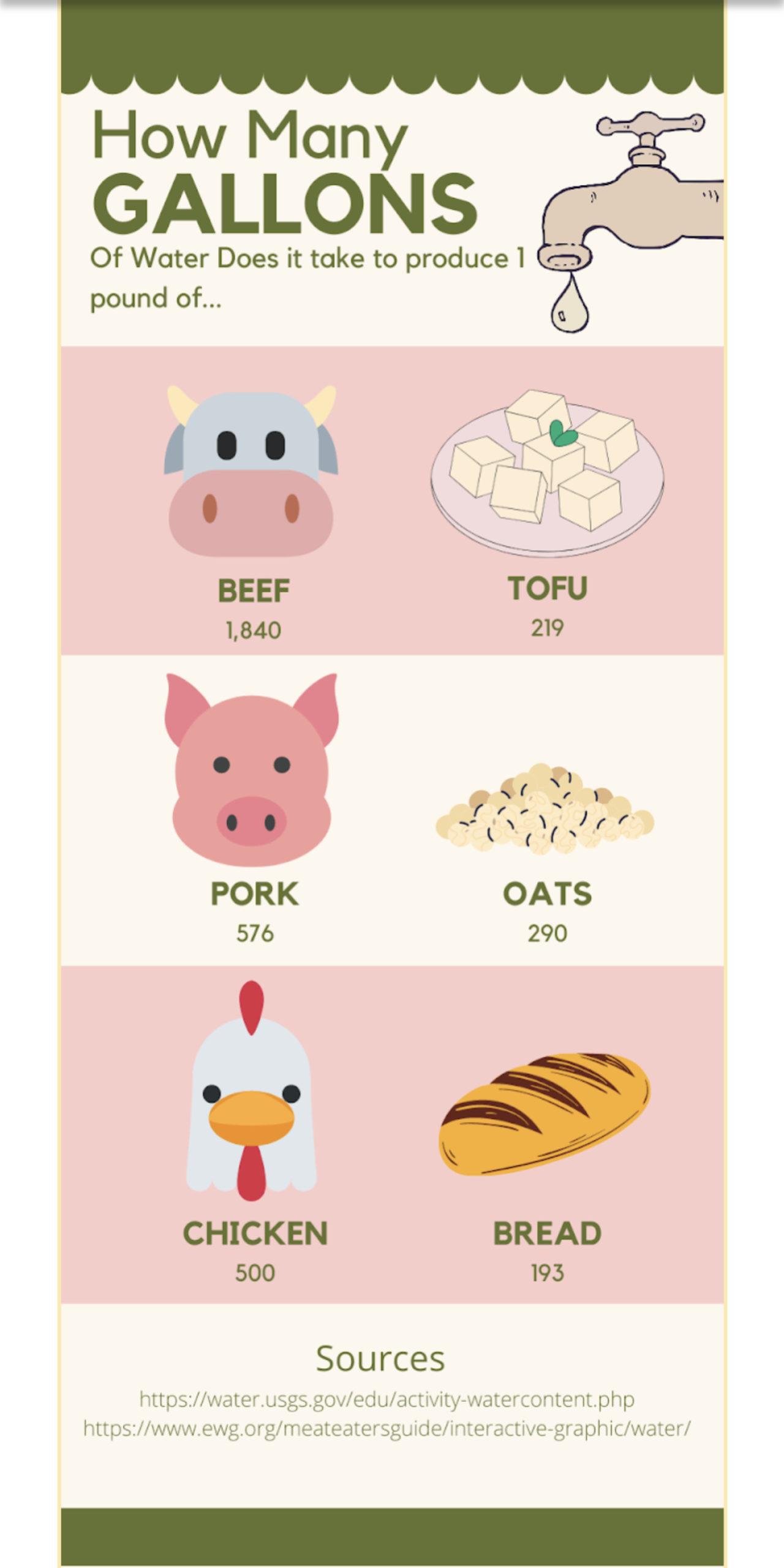In April, The Daily Mail, a British newspaper, sent America’s meat lovers into shock when it published an article about possible steps to be taken toward meeting Joe Biden’s climate plan. Pulling information from studies by Michigan University’s Center for Sustainable Systems and The University of Maryland’s School of Public Policy, The Daily Mail announced that in order to meet President Biden’s goal of a 100% clean energy economy and net-zero emissions by 2050, Americans would need to cut their red meat consumption by 90%, switch to electric cars, and heat their homes electrically instead of with gas or oil.
In response, Fox News, a traditionally right-wing media company, aired a graphic displaying “Biden’s Green Targets,” which displays Michigan University’s findings on possible dietary remedies to achieving Biden’s Climate plans. Notably, the Fox News infographic implied that one of Biden’s targets is to reduce American meat consumption by 90%, allowing for the consumption of approximately 1 burger per month per person. Subsequently, several right-wing politicians such as Congresswoman Lauren Boebert fervently tweeted out against these dietary recommendations.
But are Michigan University’s findings really that bizarre of a suggestion? Through an analysis of population increase, food production, and diet-related emissions released per person per day (measured in CO2), replacing just half of the animal-based food products we consume with plant-based food products will significantly decrease diet-related emissions and bring the United States closer to Biden’s climate plan. Furthermore, Michigan University’s study highlights that if United States citizens reduced their beef consumption by 90%, diet-related emissions would be cut by a whopping 51%, aligning the United States to be on track towards meeting Biden’s climate plan goals.
Thanks to the mass production of animal-based products through Concentrated Animal Feeding Operations (CAFOs), Americans have enjoyed larger, cheaper, and more quality-controlled animal-based products. However, these benefits come at a price—rising global temperatures. Greenhouse gasses are one of the most potent contributors to climate change, which Biden is attempting to mitigate through his climate plan. In the agricultural domain, the lead producer of greenhouse gasses is cattle. Cattle produce an astonishing amount of methane, approximating to be 220 pounds of methane per year per cow. These methane emissions, which account for 50% of the livestock sector’s greenhouse gas emissions, contribute to the greenhouse effect, alongside other greenhouse gasses common in the livestock sector, such as Carbon Dioxide (CO2) and Nitrous Oxide (N2O). Greenhouse gasses linger in the atmosphere, trapping heat and thus increasing global temperatures. Consequently, greenhouse gasses contribute to glaciers and icebergs melting, arid regions becoming riddled with drought, and heatwaves scorching Earth’s surfaces. Overall, livestock emissions are responsible for 14.5% of greenhouse gas emissions globally—a percentage that can be decreased through discouraging mass animal-based product production.
While greenhouse gas emissions via livestock production prove a huge threat to the Earth’s climate, inefficient water usage is a danger of its own. The livestock production process calls for many steps in order to grow animals to marketable standards. Throughout this process, livestock populations consume approximately 6 billion tons of animal feed per year and ⅓ of the global cereal production, which heavily contributes to livestock’s water footprint. Additionally, each animal requires an adequate water supply in order to maintain health and hydration. All of the water that is used in the cultivation of livestock accumulates and results in animal-based products being a much more water-inefficient source of food in comparison to plant-based products. In fact, producing 1 pound of beef requires approximately 1800 gallons of water—a colossal and unjustifiable amount. Comparatively, producing 1 pound of rice, a staple crop, requires approximately 420 gallons of water. American citizen’s overindulgent meat consumption contributes to the United States’ imprudent water usage, causing the United States to use the most water per capita in comparison to any other industrialized country.
More conscious consumption is vital to preserving Earth’s climate and natural resources. If dietary habits are not to change, by 2030 greenhouse gas emissions affiliated with food production are to increase by 9%, in concurrence with the world’s exponentially growing population. Earth’s global temperature will continue to rise, and thus, glaciers and icebergs will continue to melt as our favorite vacation destination, such as the Bahamas, will slowly submerge into the sea. If we continue exploiting water sources at our current rate, we can look forward to 1.8 billion people living in areas with absolute water scarcity by 2025. Earth’s population is growing exponentially and the increasing demand for food and water is unavoidable. Water sources that serve large populations, such as the Ogala aquifer, are already being used at an unsustainable rate. If we do not change our dietary habits, we can anticipate a very dry and hot future.
As a teenager, we can not single-handedly tackle the covetous companies controlling the meat industry. Fortunately, by following the basic economic principle of supply and demand, when demand for a product decreases, supply will follow suit. Decreasing demand for animal-based products will lead to a reduction in production, and thus a depletion in the amount of livestock greenhouse gasses emitted into the atmosphere. Through the individual choices we make to take on “Meatless Monday,” pack our own plant-based lunches instead of falling victim to cafeteria mystery meat, and more, we can influence the meat industry. And while meat is an excellent source of protein, there are several plant-based protein options that curtail the necessity to consume meat. Soybean-based tofu, quinoa, and oats are all excellent alternatives to meat that can be incorporated into a variety of meals and cooking styles and are much more water-efficient than animal-based products.
The Earth’s atmosphere and natural resources should be treated for what they are: shared resources, instead of marketable goods. Alleviating the effects of climate change and preventing depletion of water sources starts through the individual choices we make by staying informed and consuming more consciously.
VOX Media Cafe reporter Catherine McEntaggart is 17.




